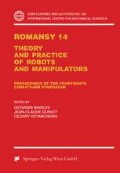Abstract
The major objective of this paper is to preserve the general idea of hybrid position/force control, and to develop concrete control procedure based on assumptions different from those adopted in the traditional hybrid control. Without rejecting the general idea of hybrid control, which had been based on the theoretically unjustified concept of “orthogonal complements”, we showed that the control partition can be based on another principle, which was realized in simultaneous control of the position and force. On the basis of this principle we synthesized in an explicit form the control law involving both position and force feedback loops.
Access this chapter
Tax calculation will be finalised at checkout
Purchases are for personal use only
Preview
Unable to display preview. Download preview PDF.
References
Raibert M.H., and Craig J.J. (1981). Hybrid position/force control of manipulators, ASME journal of dynamic systems, measurement and control, Vol. 102, No 3.
Mason M.R. (1981). Compliance and force control for computer controlled manipulators, IEEE trans. on systems, man and cybernetics, Vol. SMC-11, No 6.
Duffy J. (1990). The fallacy of modern hybrid control theory that is based on orthogonal complements of twist and wrench spaces, journal of robotic systems, Vol. 7, No 2.
De Luca A., Manes C. (1994). Modelling of robots in contact with a dynamic environment, IEEE trans. on robotics and automation, Vol. 10, No 4.
Vukobratovib M., Ekalo Yu. (1993). New approach to control laws synthesis for robotic manipulators in contact with dynamic environment, tutorial S5: Force and contact control in robotic systems: A historical perspective and current technologies, IEEE intern. conference on robotics and automation, Atlanta.
Vukobratovi6 M., Ekalo Yu. (1996). New approach to control of robotic manipulators interacting with dynamic environment, Robotica, Vol. 14, pp. 31–39.
Turk S., Otter M. (1987). Das devlr model!. Nr 1 des industrieroboters manutec r3, robotersysteme 3, pp. 101–106.
Khatib 0. (1987). A unified approach for motion and force control of robot manipulators: the operational space formulation, IEEE journal of robotics and automation, Vol. 3, No 1.
Author information
Authors and Affiliations
Editor information
Editors and Affiliations
Rights and permissions
Copyright information
© 2002 Springer-Verlag Wien
About this chapter
Cite this chapter
Vukobratovič, M., Ekalo, Y., Rodič, A. (2002). How to Apply Hybrid Position/Force Control to Robots Interacting with Dynamic Environment. In: Bianchi, G., Guinot, JC., Rzymkowski, C. (eds) Romansy 14. International Centre for Mechanical Sciences, vol 438. Springer, Vienna. https://doi.org/10.1007/978-3-7091-2552-6_27
Download citation
DOI: https://doi.org/10.1007/978-3-7091-2552-6_27
Publisher Name: Springer, Vienna
Print ISBN: 978-3-7091-2554-0
Online ISBN: 978-3-7091-2552-6
eBook Packages: Springer Book Archive

